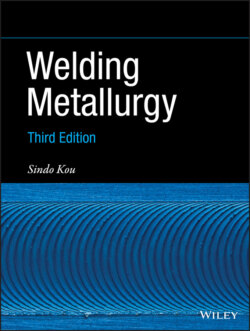Читать книгу Welding Metallurgy - Sindo Kou - Страница 65
2.1.1.2 Measurements
ОглавлениеThe heat source efficiency can be measured with a calorimeter. The heat transferred from the heat source to the workpiece is in turn transferred from the workpiece to the calorimeter, which can be determined as follows.
Kou and coworkers [1, 2] used simple tubular calorimeters to determine the arc efficiency in GTAW of aluminum, as shown in Figure 2.2a. The calorimeter can be a tube if the workpiece is a tube. It can also be a rectangular box if the workpiece is a plate, which can be the cover of the box and an O‐ring can be provided between the cover and the rest of the box to keep water from leaking out of the box. The temperature rise in the cooling water (T out − T in) can be measured using thermocouples or thermistors. Heat transfer from the workpiece to the calorimeter is as follows [1–3]:
(2.3)
where W is the mass flow rate of water, C the specific heat of water, T out the outlet water temperature, T in the inlet water temperature, t is time, and t weld is welding time. The integral in Figure 2.2a corresponds to the shaded area in Figure 2.2b. The arc efficiency η can be determined from Eqs. (2.2) and (2.3).
Figure 2.2 Measurement of arc efficiency in GTAW: (a) calorimeter; (b) rise in cooling water temperature as a function of time. WC is taken as constant because W is constant and C essentially constant.
Source: Kou et al. [1]. © TMS.
Giedt et al. [4] developed a Seebeck envelop calorimeter to measure the arc efficiency in GTAW. The name Seebeck came from the Seebeck thermoelectric effect of a thermocouple, namely, a voltage is produced between two thermocouple junctions of different temperatures. This calorimeter was later used to determine the arc efficiencies in GMAW, plasma arc welding (PAW), and submerged arc welding (SAW) [5–8].
Figure 2.3 GTAW vs. PAW: (a) GTAW; (b) PAW. Cooling by orifice gas nozzle and leaking from keyhole bottom make arc efficiency lower in PAW than GTAW.
As compared to GTAW, PAW has two extra heat losses as shown in Figure 2.3: (i) heat loss to the orifice gas nozzle, which is water‐cooled; and (ii) heat loss by the plasma leaking out from the bottom of the keyhole. Figure 2.4 shows the arc efficiency is lower in PAW than in GTAW [2, 5, 7, 9].
Figure 2.4 Arc efficiencies in GTAW and PAW.
Figure 2.5 shows that GMAW and SAW both have a high arc efficiency [7, 10]. These results were obtained using the two types of calorimeters described previously, except for the results of Lu and Kou for GMAW [10, 11], which are described as follows.
Figure 2.5 Arc efficiencies in GMAW and SAW.
In GMAW, the arc, metal droplets, and cathode heating all contribute to the efficiency of the heat source. It has been observed in GMAW of aluminum and steel with Ar shielding that current flow or electron emission occurs over localized areas on the workpiece surface called cathode spots [12, 13]. The localized heating, called cathode heating, causes the surface oxide to dissociate and leaves a clean metal surface [12]. Cathode heating is attributed to field‐type emission of electrons. Unlike thermionic emission at the tungsten electrode in direct current (DC) electrode‐negative GTAW, field emission electrons do not cool the cathode [6].
Lu and Kou [10, 11] used a combination of three calorimeters to estimate the amounts of heat transfer from the arc, filler metal droplets, and cathode heating to the workpiece in GMAW of aluminum. Figure 2.6a shows the measurement of heat transfer from droplets [11]. The arc is established between a GMAW torch and a GTAW torch and the droplets collect in the calorimeter below. From the water temperature rise and the masses and specific heats of the water and the copper basin, the heat transfer from droplets can be determined. Figure 2.6b shows the measurement of the total heat transfer to the workpiece. The calorimeter is a rectangular box and the workpiece is the cover of the box, with an O‐ring provided between it and the rest of the box to keep water from leaking out of the box. Figure 2.6c shows the measurement of the combined heat transfer from the arc and the droplets, with cathode heating shifted to the tungsten electrode of the GTAW torch next to it [10].
Figure 2.6 Calorimeter for measuring heat inputs in GMAW: (a) metal droplets; (b) total heat input; (c) combined heat inputs from arc and metal droplets.
Source: Lu and Kou [10, 11]. Welding Journal, September and November 1989, © American Welding Society.
The results are shown in Figure 2.7a. Cathode heat transfer was determined by subtracting the combined heat transfer from the arc and droplets from the total heat transfer to the workpiece, as shown in Figure 2.7b. Within the range of the power studied, the overall efficiency was about 80%, with about 45% from the arc, 25% from droplets, and 10% from cathode heating.
Figure 2.7 Power inputs during GMAW of aluminum: (a) measured results; (b) break‐down of total power input.
Source: Lu and Kou [10]. Welding Journal, September 1989, © American Welding Society.
The heat source efficiency can be very low in LBW because of the high reflectivity of metal surfaces to a laser beam – for instance, 98% for CO2 laser on a highly polished Al or Cu surface. The reflectivity can be found by determining the ratio of the reflected beam power to the incident beam power. Xie and Kar [14] show that roughening the surface with sandpapers and oxidizing the surface by brief exposure to high temperatures can reduce the reflectivity significantly.
